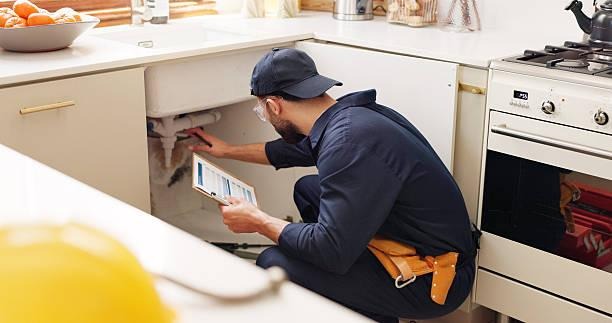
In many parts of the world, winter brings frigid temperatures that cause the temperature to plummet. When this happens, the water supply around your home’s faucets and fixtures may freeze inside the water lines.
Since water cannot be used or moved when it turns to ice, frozen pipes can burst, leading to costly plumbing damage around almost all water outlets in your home. The pipes that are at the highest risk of freezing are those outside and those in unheated or uninsulated areas, such as the attic, basement, and garage.
Before the temperature drops below freezing, it’s essential to know how to prevent your water lines from freezing and take the necessary steps to protect your home.
This article provides simple tips on how to protect your pipes before and during winter in Marietta, GA, as well as outlines the proper steps to take when your water lines freeze, when to seek professional help, and how to thaw them to prevent major home disasters.
Disconnect Garden Hoses
Once you are done tending to your garden for the season, disconnect, drain and store all your hoses. Close off any valve that supplies outdoor hose bibs and open the outside faucet to drain the line.
Ensure that you keep them open throughout the winter to allow space for any water that remains inside the pipes to expand.
You can also consider using faucet covers throughout the cold days for better protection from frozen pipelines.
Furthermore, ensure that you drain water from any sprinkler supply lines according to the manufacturer’s instructions.
Insulate Your Pipes

Insulating your pipelines won’t cost you much, and you can usually find the service at home improvement stores. Check all pipes located around unheated areas, such as the attic, basement, crawl spaces, and garage.
During those extremely cold months, pipes underneath the kitchen and bathroom sinks are also prone to freezing. Consider applying foam insulation liberally to add an extra buffer against the frigid temperatures.
To make things easier and tidier to fix, wrap premade foam insulation sleeves around all the pipelines.
Also, wrap them using heat tape or thermostat-controlled heat cable to keep them warm enough to prevent freezing.
Seal Air Leaks
Check around your home for any cracks or openings that could allow cold air inside. Seal those holes around the piping, interior or exterior walls and insulate where the foundation of your home is resting.
Furthermore, always keep your garage door closed unless you are going inside or outside, as leaving it open can create a significant air leak.
Open Doors and Cabinets
Ensure that warm air circulates adequately around your home during the cold months. Interior doors should be left ajar, as well as your kitchen and bathroom cabinets, so heat is distributed evenly throughout the rooms.
Remove any household chemicals or cleaners that are considered harmful from your open cabinets, especially if you have small children or pets in the household.
Let Faucets Drip
Even a small amount of water flowing through your pipes can prevent them from freezing. When it is extremely cold outside, pour a drip of water along all the exposed pipes so they will reach the inner faucets.
You can also consider leaving a few faucets running slightly to relieve the pressure inside the pipes and prevent them from bursting in case the water becomes frozen.
Keep a Consistent Temperature

Your thermostat should be set to maintain a consistent temperature throughout the day and night. On normal days, consider lowering the thermostat at night or when you are not home to save on electricity heating costs.
However, during cold months, maintain a steady temperature to prevent your pipelines from freezing. And whenever you are going away from home, especially during the cold months, make sure to set the thermostat to at least 55°F.
You may be spending a few extra dollars here, but keep in mind that it is worth preventing you from the thousands you may end up spending when the pipe bursts.
What to Do if Your Pipes Freeze
Once you discover your pipe has become open, begin by turning on the faucet. If it’s only a drop or trickle of water that flows out, it’s an indication of blockage. The next step is to scrutinize the exposed water lines for any cracks or breaks. If a pipe has burst, turn off the main water supply to your home and contact an emergency plumbing service Marietta GA, immediately. Don’t attempt to thaw burst pipes yourself, as it may result in water flowing out and flooding your house.
If your pipes are still intact, turn on the faucet and allow water to flow through, which will help melt the ice.
You can also gently apply heat to the area that has frozen around the pipe using gentle heating devices, such as hot, warm, and damp clothes, a heating pad, or a hair dryer.
Avoid using an open flame to thaw your frozen pipelines, as it can result in a fire hazard and cause significant damage to the pipe. If you are not able to access or safely thaw the pipes, call a professional plumber to handle the problem.
Conclusion
A quality water supply around all outlets in your home can make life easier, but on winter days, water lines are prone to freezing, which makes it essential to take major precautions to protect your home from this situation.
Some of these ways include sealing air leaks and insulating your pipes, which are tasks you can do yourself.
However, in cases of a burst, avoid trying to thaw the pipes yourself. This is a case that needs the attention of a professional plumber. Don’t use an open flame to defrost the water lines; instead, when they have frozen, gently use mild heat, such as that of a hairdryer or heating pad.
